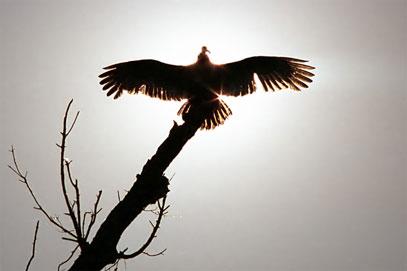Environmental toxin continues to threaten vultures
Nearly 18-months after Indian officials banned the use of the pain killer diclofenac in farm animals residual amounts persist in the vulture population there. However, scientists are hopeful that, in time, all traces of the drug will disappear from the ecosystem ensuring the vultures continued survival.

photo courtesy: Allen Matheson
Debbie Pain, head of international research at the UK's Royal Society for the Protection of Birds RSPB) first called attention to the looming environmental disaster in January 2004 when she reported, “The decline of three raptor species of vulture across South Asia has been absolutely catastrophic,"
A year later the BBC in an Article March 2005 reported that a ban had been announced by Indian officials noting that: "Vultures hold a critical position in the food chain and are renowned for their ceaseless scavenging. But their once-abundant numbers have been in decline for more than a decade."
Our media partner, The Animal Broadcast Network reported that, recent evidence links the use of the drug diclofenac to manage pain in agricultural livestock to the dramatic decline in the populations of three species of vultures in Asia. Diclofenic is from a class of drugs called nonsteroidal anti-inflammatory drugs (NSAIDs). Diclofenac works by reducing hormones that cause inflammation and pain in the body."
Asian farmers began using the drug in livestock during the 90s and the resultant spread through the eco system has led researchers to conclude that it is the primary cause for the decline in vulture populations. Vultures fulfill their necessary role in the environment by scavenging dead animal carcasses and thereby over time accumulate toxic levels of dicofenac leading to kidney failure and ultimately, death.
In some areas, the decline has reached an alarming 99%, which puts the vulture at the top of the endangered species list. The resultant ripple effect through the system is the increase of other less desirable scavenger populations like feral dogs. An increase in the propagation of human diseases would follow.
This week, research publisher Science Daily has a follow up to the story Vultures at risk reporting that starting August 12, 2006, the production and importation of veterinary diclofenac is no longer permitted in India as conservationists continue their efforts to save the vultures from extinction.
by Nancy Lee
Greener Magazine
Update::Drug firm backs vulture recovery plan
16 August 2006
New Scientist
submitted by Chris in the UK

 Editor's note:: Action for Amimals 2006 gets underway September 2nd in Washington DC. This is the second annual national conference sponsored by animal welfare groups and promises some great presentations and a special guest performance by songwriter, singer Nellie McKay.
Editor's note:: Action for Amimals 2006 gets underway September 2nd in Washington DC. This is the second annual national conference sponsored by animal welfare groups and promises some great presentations and a special guest performance by songwriter, singer Nellie McKay.

photo courtesy: Allen Matheson
Debbie Pain, head of international research at the UK's Royal Society for the Protection of Birds RSPB) first called attention to the looming environmental disaster in January 2004 when she reported, “The decline of three raptor species of vulture across South Asia has been absolutely catastrophic,"
A year later the BBC in an Article March 2005 reported that a ban had been announced by Indian officials noting that: "Vultures hold a critical position in the food chain and are renowned for their ceaseless scavenging. But their once-abundant numbers have been in decline for more than a decade."
Our media partner, The Animal Broadcast Network reported that, recent evidence links the use of the drug diclofenac to manage pain in agricultural livestock to the dramatic decline in the populations of three species of vultures in Asia. Diclofenic is from a class of drugs called nonsteroidal anti-inflammatory drugs (NSAIDs). Diclofenac works by reducing hormones that cause inflammation and pain in the body."
Asian farmers began using the drug in livestock during the 90s and the resultant spread through the eco system has led researchers to conclude that it is the primary cause for the decline in vulture populations. Vultures fulfill their necessary role in the environment by scavenging dead animal carcasses and thereby over time accumulate toxic levels of dicofenac leading to kidney failure and ultimately, death.
In some areas, the decline has reached an alarming 99%, which puts the vulture at the top of the endangered species list. The resultant ripple effect through the system is the increase of other less desirable scavenger populations like feral dogs. An increase in the propagation of human diseases would follow.
This week, research publisher Science Daily has a follow up to the story Vultures at risk reporting that starting August 12, 2006, the production and importation of veterinary diclofenac is no longer permitted in India as conservationists continue their efforts to save the vultures from extinction.
by Nancy Lee
Greener Magazine
Update::Drug firm backs vulture recovery plan
16 August 2006
New Scientist
submitted by Chris in the UK

 Editor's note:: Action for Amimals 2006 gets underway September 2nd in Washington DC. This is the second annual national conference sponsored by animal welfare groups and promises some great presentations and a special guest performance by songwriter, singer Nellie McKay.
Editor's note:: Action for Amimals 2006 gets underway September 2nd in Washington DC. This is the second annual national conference sponsored by animal welfare groups and promises some great presentations and a special guest performance by songwriter, singer Nellie McKay.



9:36 PM









<< Home